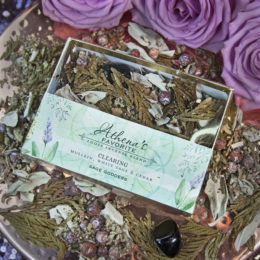Your cart is currently empty!
Black Sapphire Guide: Properties and Meaning

Black Sapphire Properties
Color: BlackMohs Hardness: 9Chakra: Root, Third EyeCrystal Structure:TrigonalLocation: Madagascar, Australia, Sri Lanka
About Black Sapphire
Black Sapphire is a powerful stone associated with the Root and Third Eye chakras. It is known for its grounding and protective properties, helping to ward off negativity and maintain calm in chaotic situations. Its deep black color symbolizes its ability to absorb negative energy and transform it into positive energy. Black Sapphire also enhances trust and confidence in intuitive abilities, making it a valuable companion for mediums and clairvoyants. As a teaching stone, it grants access to wisdom and clarity, making it an excellent tool for those seeking spiritual growth and enlightenment.
The history of Black Sapphire
The history of Black Sapphire dates back centuries, with its origins rooted in ancient civilizations. It has been highly regarded for its protective and grounding qualities throughout history. In ancient times, Black Sapphire was used by shamans and spiritual leaders for divination and spiritual guidance. It was also treasured by royalty and nobility, who believed it brought them good fortune and protection. Today, Black Sapphire continues to be highly sought after for its metaphysical properties and is cherished by those seeking balance, protection, and spiritual growth.
What are the healing properties of Black Sapphire?
Black Sapphire is a powerful stone associated with the Root and Third Eye chakras. It wards off negativity and maintains calm in chaotic situations. Its deep black color symbolizes its ability to absorb negative energy and transmute it into positive energy.
What are the metaphysical/spiritual properties of Black Sapphire?
Black Sapphire is associated with the Root and Third Eye chakras. It enhances trust and confidence in intuitive abilities, making it a powerful companion for mediums and clairvoyants. As a teaching stone, it provides access to wisdom and clarity, making it an excellent tool for those seeking spiritual growth and enlightenment.
How does Black Sapphire balance and align the Root and Third Eye chakras?
Black Sapphire balances and aligns the Root and Third Eye chakras. It promotes grounding, protection, and spiritual growth.
Black Sapphire FAQ
What is Black Sapphire used for?
Black Sapphire is commonly used in jewelry, particularly in rings, necklaces, and earrings. It is also used as a decorative stone in various settings. Due to its durability and stunning black color, Black Sapphire is highly sought after for its aesthetic appeal.
What does Black Sapphire do?
Black Sapphire has protective properties, shielding the wearer from negative energies and promoting mental clarity. It enhances intuition and psychic abilities. Additionally, Black Sapphire brings balance and stability to one’s emotions, helping to alleviate stress and anxiety.
Can Black Sapphire go in water?
Yes, Black Sapphire can be safely submerged in water. It is a durable gemstone that can withstand exposure to water without being damaged. However, it is always recommended to consult with a professional jeweler or gemologist for specific care instructions.
How to cleanse Black Sapphire?
To cleanse Black Sapphire, you can place it under running water for a few minutes or soak it in a bowl of water mixed with mild soap. Gently scrub the gemstone with a soft brush to remove any dirt or debris. After cleansing, rinse it thoroughly and pat it dry with a soft cloth.
What does Black Sapphire do spiritually?
Black Sapphire has strong spiritual properties. It enhances spiritual growth and deepens one’s connection to higher realms. Black Sapphire also aids in meditation, helping to calm the mind and promote inner peace.
How to clean Black Sapphire?
To clean Black Sapphire jewelry, you can use a soft cloth or a jewelry cleaning solution specifically designed for gemstones. Gently wipe the gemstone to remove any dirt or oils. Avoid using harsh chemicals or abrasive materials that may scratch or damage the stone.
How to spot fake Black Sapphire?
To spot a fake Black Sapphire, you can examine its color, clarity, and hardness. Genuine Black Sapphires have a deep black color with a high level of transparency. They are also quite hard, measuring 9 on the Mohs scale. If a Black Sapphire appears too light in color, lacks transparency, or scratches easily, it may be a fake.
Is Black Sapphire toxic?
No, Black Sapphire is not toxic. It is a naturally occurring gemstone that does not pose any health risks when handled or worn. However, it is always important to exercise caution and consult with a professional if you have any concerns.
Where is Black Sapphire found?
Black Sapphire is found in various parts of the world, including Australia, Thailand, Sri Lanka, and Madagascar. These regions are known for producing high-quality Black Sapphires with excellent color and clarity.
How is Black Sapphire pronounced?
Black Sapphire is pronounced as “blak suh-fahyuh”.
What chakra is associated with Black Sapphire?
Black Sapphire is associated with the Root Chakra, which is located at the base of the spine. It helps ground and stabilize one’s energy, promoting a sense of security and strength.
Can Black Sapphire be in the sun?
Yes, Black Sapphire can be exposed to sunlight without any adverse effects. However, prolonged exposure to direct sunlight may cause the color of the gemstone to fade over time. It is recommended to store Black Sapphire jewelry in a cool, dark place when not being worn.
How to charge Black Sapphire?
To charge Black Sapphire, you can place it in direct moonlight overnight or bury it in the earth for a few hours. This allows the gemstone to absorb the natural energies of the moon or the earth, revitalizing its metaphysical properties.
What is the hardness of Black Sapphire?
Black Sapphire has a hardness of 9 on the Mohs scale, making it one of the hardest gemstones available. This high level of hardness ensures that Black Sapphire is resistant to scratches and can withstand everyday wear and tear.













